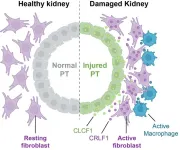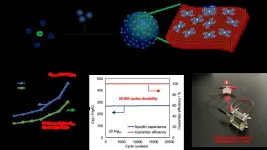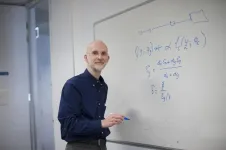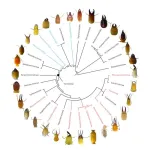(Press-News.org)
A study published in Nature Communications provides new insight into how damaged cells interact within disease-promoting microenvironments following acute kidney injury, or AKI. With limited treatment options, AKI frequently progresses to chronic kidney disease (CKD), which affects more than 1 in 7 U.S. adults—an estimated 37 million people.
The new findings may contribute to future efforts to prevent CKD, which can lead to kidney failure.
The study brought together scientists from Andy McMahon’s lab at USC and Long Cai’s lab at Caltech, with support from a USC Broad Innovation Award that funded the cross-institutional research collaboration.
In the study, co-first authors Michal Polonsky from Caltech and Louisa Gerhardt from USC, leveraged a cutting-edge tool, called seqFISH, developed in the Cai laboratory. With this tool, researchers can gather information about genetic activity and study cellular interactions in intact kidney tissue in mice with AKI. This allowed the scientists to analyze the precise expression of over 1,000 genes in the injured kidney tissue, identify microenvironments associated with injury, and predict cellular interactions associated with the progression to CKD.
“Dr. Cai’s seqFISH technology provides unprecedented insight into the cellular interplay in the kidney following injury,” said McMahon, who is the W.M. Keck Provost and University Professor of Stem Cell Biology and Regenerative Medicine at USC and will join the faculty of Caltech in October. “A better understanding of kidney injury is needed to identify targets for preventing the progression to chronic kidney disease.”
Cai, who is a Professor of Biology and Biological Engineering, added: “We’re thrilled that our technology has enabled a deeper understanding of kidney injury and disease. This study exemplifies the importance of cross-institutional and cross-disciplinary collaborations to advance biomedical research.”
In the kidney’s outermost layer, the scientists identified a likely pathological microenvironment, which they dubbed “ME-5.” This microenvironment contained a type of kidney cell particularly vulnerable to injury, known as a proximal tubule cell or PT.
In ME-5, injured PTs and neighboring connective tissue cells, known as fibroblasts, exchanged signals that could drive injury progression. Key signals involved the genes Clcf1 and Crfl1, which encode proteins that can promote inflammation and fibrosis, or scarring. Additional signals detected in ME-5 could contribute to recruitment of immune cells, thereby further contributing to development of inflammation, fibrosis and other pathological changes.
The scientists also identified another important injury-associated microenvironment, which they named “ME-16,” featuring aggregations of various immune cell types called tertiary lymphoid structures that are known to contribute to chronic inflammation. Rather than being confined to a specific region of the kidney, ME-16 was distributed throughout the injured organ.
To share their discoveries, the team constructed a comprehensive map of cellular, molecular, and structural changes following AKI, which refines our understanding of the transition to CKD. This map is publicly available at https://woldlab.caltech.edu/ci2-celltiles/Mouse-Kidney-Fibrosis/.
Additional co-authors are Kari Koppitch from USC; Jina Yun, Katsuya Lex Colón, Henry Amrhein, Matt Thomson, and Barbara Wold from Caltech; and Shiwei Zheng and Guo-Cheng Yuan from the Icahn School of Medicine at Mount Sinai.
In addition to the USC Broad Innovation Award, the research was supported by the National Institutes of Health (grant NIDDK UC2DK126024), German Research Foundation (grant GE 3179/1-1), and German Society of Internal Medicine (DGIM) Clinician Scientist Grant.
Disclosures
Cai is a cofounder of Spatial Genomics, Inc. McMahon is a consultant to eGENESIS, Trestle Biotherapeutics, IVVA Medical, and GentiBIO.
END
Honesty is the best policy… most of the time. Social norms help humans understand when we need to tell the truth and when we shouldn’t, to spare someone’s feelings or avoid harm. But how do these norms apply to robots, which are increasingly working with humans? To understand whether humans can accept robots telling lies, scientists asked almost 500 participants to rate and justify different types of robot deception.
“I wanted to explore an understudied facet of robot ethics, to contribute to our understanding of mistrust ...
Researchers at Tohoku University have successfully increased the capacity, lifetime durability, and cost-effectiveness of a capacitor in their pursuit of a more power-efficient future. A capacitor is a device used as part of a circuit that can store and release energy, just like a battery. What makes a capacitor different from a battery is that it takes much less time to charge. For example, your cellphone battery will power your phone instantly, but charging that battery back up to 100% when it dies is far from instantaneous.
While this makes capacitors sound like the superior choice, they have some big drawbacks that need to be overcome. Firstly, their capacity is much smaller ...
New research has discovered a unique and promising avenue for diagnosing Alzheimer’s disease (AD) earlier – by analysing AD biomarkers in blood – so that the impacts of dementia can be reduced.
AD is the most common form of dementia, estimated to contribute to 60-70 per cent of cases, or more than 33 million cases worldwide, according to the World Health Organisation. Currently incurable, AD is usually diagnosed when a person is having significant difficulties with memory and thinking that impact their daily life.
University of Melbourne researcher Dr Brandon Mahan leads a group of analytical geochemists from the Faculty ...
WEHI’s Bioinformatics division head, Professor Gordon Smyth, has won the 2024 Eureka Prize for Excellence in Research Software.
The award recognises Prof Smyth’s lead role in developing and designing the limma software package, which helps researchers detect changes in gene activity.
limma has helped researchers around the world detect changes in gene activity – a crucial element to finding new treatments for a range of diseases, like cancer – and has been used or cited in more than 70,000 published papers worldwide.
The Australian Museum Eureka Prizes are ...
Termites have a bad reputation. Most think of them as pests, a status that isn’t helped by their recent reclassification into the cockroach family.
But not only do the termites that cause serious problems for humans only make up 3.5% of all termite species, termites also serve as crucial ecosystem engineers, maintaining the infrastructure of various environments. Like earthworms, they circulate nutrients by decomposing plant materials, and they play the important role of bioturbators: much like plowing a field, termites aerate the soil, expose underground nutrients, and let water infiltrate deeper layers of soil – ...
Drought stress has long been a limiting factor for crop production around the world, a challenge exacerbated by climate change.
For more than a century, scientists have targeted a key plant trait known as water use efficiency (WUE) to help crops grow with less water and avoid suffering from drought stress. Greater WUE can help plants avoid drought stress — but for most crops it’s also associated with lower productivity when water is plentiful.
In a pair of new studies published in the Journal of Experimental Botany, ...
Learning new languages, sending emails, attending a virtual class, or speaking to loved ones halfway around the world are just some of the tasks accomplished by touching a button on a smartphone. Unfortunately, the ease and convenience of modern devices have also come with a painful crick in the neck. The sedentary nature of work and prolonged use of hand-held devices and computers have contributed to a sharp increase in neck pain.
While fatigue in neck muscles has long been suspected of causing pain, the actual mechanical changes in the spine and muscles that precede weakness remain an outstanding question.
Now, using high-precision X-ray ...
Long term exposure to fine particulate matter (PM2.5) air pollution is linked to a higher risk of infertility in men, whereas road traffic noise is linked to a higher risk of infertility in women over 35, finds a Danish study published by The BMJ today.
If these findings are confirmed in future studies, they could help guide strategies to regulate noise and air pollution to protect the general population from these exposures, say the researchers.
Infertility is a major global health problem affecting one in seven couples trying to conceive.
Several ...
Rates of prostate cancer across Europe since 1980 are “indicative of overdiagnosis”, say researchers in a study published by The BMJ today.
Overdiagnosis refers to the detection of harmless cancers that are unlikely to cause symptoms or death during a patient’s lifetime, which can lead to unnecessary treatment, negative impacts on quality of life, and wasted healthcare resources.
The findings show rapid increases in the number of new cases (incidence) in parallel with uptake of so far predominantly opportunistic ...
Four in ten children in Central London who travelled to school by car switched to more active modes of transport, such as walking, cycling, or public transport, following the introduction of the Ultra-Low Emission Zone (ULEZ), according to new research. In the comparison area with no ULEZ, Luton, only two in ten children made this switch over the same period.
Car travel contributes to air pollution, a major cause of heart and lung diseases including asthma attacks. Beyond this, it limits children's opportunities for physical activity, hindering their development and mental health, and increasing their risk of obesity and chronic illnesses.
Despite ...







